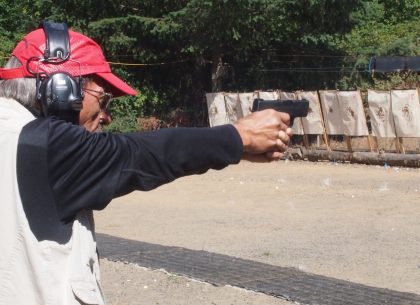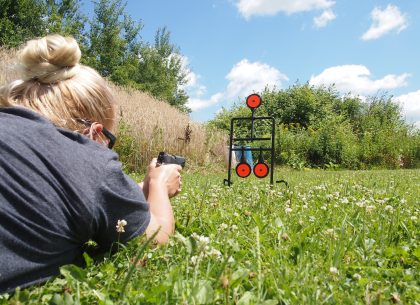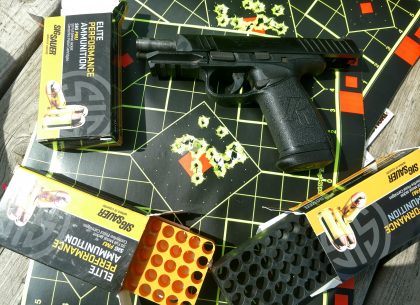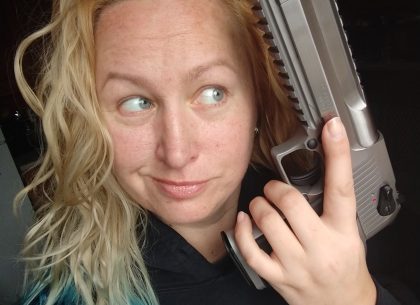When people think of long-range shooting, minds inevitably zero in on rifles. Sure, it’s fun to ring steel at 500 yards, 1000 yards, even 2000 yards, but there is another area of your shooting skills you should be cultivating: long-range handgun shooting.
This is the part where you probably either consider stopping reading or consider what you believe long-range is with a handgun. 15 yards? 25 yards? Although it does depend on the specific handgun – magnum revolvers rock at much longer distances – we’re talking self-defense guns. We’re talking 50 yards. 100 yards. Not only can you do it but it helps build your self-defense skills in vital ways.
Foundation Skills
Before trying your hand at making long-range handgun shots, take the time to be sure you have the basics down. Grip, sight picture, trigger press – it all matters. If you’ve seen how much a seemingly small error can throw off shots at 25 yards, just imagine how big those misses will be when the distance is doubled or quadrupled.
Start by polishing your foundation skills. Pre-eminent firearms instructor Massad Ayoob teaches students to run through a five-step checklist prior to taking a shot:
- Strong stance
- High hand grasp
- Crush your grip
- Front sight
- Smooth roll of the trigger
With continued practice, this will come naturally.
 Mas Ayoob suggests students run through a five-point checklist before shooting.
Mas Ayoob suggests students run through a five-point checklist before shooting.
Practice, Practice, Practice
A great way to perfect handgun basics is through dry fire training. The classic dry fire drill of balancing a coin or empty brass on your front sight and pressing the trigger is a good way to work on your trigger press. You can also do the same drill without anything balancing on the handgun. Simply choose a blank wall or a target you’ve set up for this purpose and focus on sight alignment and a smooth trigger press. The front sight should not move when you press the trigger.
Please be sure you’re following the four rules of gun safety, even when practicing dry fire. Check and double-check that your gun is empty – not only visually but by touch. Do not keep live rounds nearby during dry fire. Using dummy rounds is a good idea for more realistic practice but not a must; most modern guns can be dry-fired with no ill effects. And when you aim your gun take care to aim at a reliable, solid backstop in a safe direction. Dry-fire is not an excuse to aim at your cat, an open door, or a random wall. Practice responsibly.
Making the Shot
It’s important to not jump into attempting 100-yard shots with your self-defense gun. Odds are you’ll end up frustrated and there’s no need for that. If you’re accustomed to shooting at 10 yards, stretch to 15 yards, then 25 yards, and so on; if you’re accustomed to 25 yards, go ahead and try 50 yards. Once you have 50-yard shots down, try 100 yards.
As mentioned above, making longer-range handgun shots is about mastering the basics but it’s also about knowing your gun. You’re going to experience significant drift and drop depending on the caliber of your gun, its barrel length, and the specific load you’re using. With some experimentation, you’ll figure out which ammunition excels at longer distances and where to hold for a good hit.
 Steel provides great auditory feedback and can be used up close with frangible ammunition or at longer distances.
Steel provides great auditory feedback and can be used up close with frangible ammunition or at longer distances.
If you aren’t hearing the feedback-ping of bullet striking steel, watch for puffs of dirt to figure out where you’re hitting and adjust accordingly. Compensate for drop by keeping your front sight on your target and shifting the rear sight downward. This means you’ll have a portion of your front sight visible above the rear sight.
There are some gear considerations for longer-range handgun shooting. Specifically, if your pistol has a thick front sight you might find it harder to get on target at greater distances. Switching out your sights so the front sight is thin could greatly improve your shooting not only at longer ranges but up close. And, of course, guns with longer barrels make those 50-yard-and-beyond shots a bit easier but that doesn’t mean you can’t do it with a shorter barrel. Practice, and be patient.
Why It’s Worth Mastering
I’ve run everything from .22 LR to .45 ACP to .500 Linebaugh out to 100 yards and even, on some occasions, 150 to 200 yards. First of all, fine-tuning your skills at longer distances will also improve your close-range accuracy. Second, not all gunfights take place at close range. I’m not saying you should engage a potential assailant at 100 yards – take a moment to consider how effective your gun would be at this distance, anyway – but never assume you’ll only need to make a shot at ten yards or less.
 Shooting long range with your handgun will also significantly boost your close-range skills. (Pictured: Remington RP9)
Shooting long range with your handgun will also significantly boost your close-range skills. (Pictured: Remington RP9)
There are documented gunfights where someone successfully defended themselves from an attack at 25 yards and beyond. If your attacker has a handgun or rifle, they can reach out and touch you without moving closer. Making sure you are competent at longer distances makes you a well-rounded shooter. It also boosts your confidence and hey, it’s fun.
Add long-range handgun work to your range time. It gives you variety and broadens your shooting horizons in a positive way. Don’t limit yourself to ten yards and under. Stretch your shooting legs by running your handgun at longer distances.
You can thank me later.
About the Author:

Kat Ainsworth covers everything from self-defense to hunting and beyond. As an outdoor writer, Field Editor for Bonnier’s Range 365, and freelancer for a wide array of industry publications, her articles are popular with both firearms enthusiasts and the gun curious alike. She has been carrying concealed for fifteen years, hunting for over twenty, and has yet to come across a firearm she didn’t want to test.
Kat will also add ‘author’ to her resume when her book, Handgun Hunting, drops with Skyhorse Publishing this fall.
When she isn’t enjoying the nomadic side of her gun-centric lifestyle, she can be found doing yoga, drinking coffee, walking her dog Puck, or spending time with her daughter in their Holliday, TX home.


Look up Ed McGivern. In the late 30’s he and Elmer Keith were shooting .357 revolvers at human size targets 600 yards away and hitting is over 50%of the time. He also set speed records with a revolver firing 5 shots in less than .5 seconds getting hand size groups at 15 feet. Twice the groups could be covered by a half dollar.